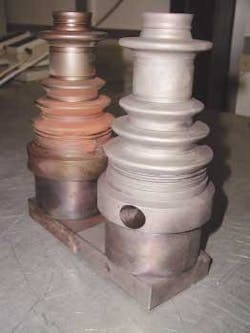Industrial laser cleaning
The use of lasers for industrial cleaning and fine arts conservation has spread because these lasers have become more performance oriented, reliable and easy to use and maintain. This, together with new and more stringent laws for environment preservation and job-safety, plus the reduction in the number of chemicals allowed, has promoted the use of lasers for industrial cleaning. In this regard, the laser cleaning technique is in fact the most attractive and flexible process.1,2 Nanosecond laser irradiation of a surface is shown to be an effective solution for the removal of sub-micron sized particle contamination, which adheres so tenaciously to a solid surface that conventional cleaning techniques are inadequate. Moreover, laser cleaning is non-contact and versatile and can be safely used on delicate surfaces.
Thus, the technique is used successfully today for different applications such as the removal of graffiti and paint from metal and polychrome surfaces. An important application for laser cleaning is art conservation, with the removal of the black encrustation resulting from pollution that ravages stone structures and monuments. Another is the restoration of aged textiles, parchments, frescos and paintings. The trend in art conservation is to clean and structurally preserve the original work, so the laser technique is preferred because it allows selective removal of pollutants without damaging the substrate.
Basics of the process
The cleaning process is based on photothermal ablation with shockwave production during the expansion of the plasma produced by the absorption of the short pulse laser beam.3 In the case of the Q-switched lasers described here, two events can happen: The layer to be removed absorbs the laser radiation and removal happens at a depth equal to the penetration of the laser radiation. The process is made efficient by the micro-explosions resulting from the shockwave produced by the plasma generated in the layer. Or, the layer to be removed is transparent to the laser wavelength, so the laser radiation interacts with the substrate and the plasma generated produces a shockwave, rejecting the overlaying layer.
In the case of paintings or colored layers, the laser light selectively acts only on the layer of its complementary color. High efficiency obtained by choosing a laser wavelength that is strongly absorbed by the layer is important to achieve faster throughput and to avoid substrate damage.
Laser source and successful treatments
Quanta System s.r.l. (Milan, Italy) has developed Nd:YAG lasers for cleaning applications. Lasers operating in the pulsed Q-switched mode, like the Palladio and Michelangelo models, generate an intense pulse that breaks up outer layers and can safely clean a lot of substrates. Typically the first laser pulse generates a plasma near the surface, ablating the superficial material. Subsequent pulses, on the same area, are diffusely reflected from the non-absorbing substrate, without damaging it. Cleaning of polychrome surfaces where color selectivity is absolutely necessary, requires a Nd:YAG laser with different harmonic wavelengths (532nm, 355nm, 266nm). Quanta System has recently introduced into the market two new laser models (Raffaello and Leonardo) with harmonic wavelengths.
These laser models are equipped with an articulated arm beam delivery. They operate in the Q-switched regime with a wide range of output fluences and high pulse energy that allows work on large areas.
Typical laser surface cleaning applications are summarized in the table which also lists laser advantages and process data. An expanded description of the most important treatments follows.
Stone cleaning
Atmospheric pollution is ravaging stone structures and monuments at an alarming rate. Pollution from fossil fuel by-products, together with airborne particles, forms the black encrustation seen on older stone surfaces.
Removal can be difficult without damaging the underlying stone substrate, which may be softer and more soluble than the polluting layer. Conventional cleaning, normally accomplished with abrasives, chemicals, solvents, swabs or electrolysis, can cause permanent damage to many surfaces. Current cleaning techniques take advantage of the high-intensity light of a laser source for surface treatment.
The procedure has been successfully extended to other substrates like wood, leather, paper, metals and ceramic.
In the specific case of stone cleaning, the dark pollution layer strongly absorbs laser radiation, while the light-colored stone substrate does not. Absorption of high energy laser pulses by the black weathering crust results in vaporization of the crust material. As soon as the light-colored unaffected stone appears, photon absorption dramatically decreases and the interaction becomes ineffective. Cleaning stoneworks with a laser can help restoring valuable surfaces to their original color and texture. Laser cleaning is effective even when the polluting layer has penetrated deeply into the substrate.
Large monuments like St. Stephen's Cathedral (Vienna, Austria) and Brandenburg Gate (Berlin, Germany) have been cleaned with success by Quanta lasers.
In the case of paintings or colored surfaces, the principle remains the same and the laser light selectively removes only the particles of its complementary color.
High efficiency, obtained by choosing a laser wavelength that is strongly absorbed by the surface, is important in practical applications to achieve faster throughput and to avoid substrate damage. Ultimately, the optimum exposure conditions depend on the media characteristics and on the contaminating layer to be removed.
Mold cleaning
Elastomeric materials used in the food industry as non-stick films require periodic replacement for hygienic reasons. The laser seems particularly fitted to this application because it removes film without the use of chemicals, leaving the metal substrate ready for an immediate deposition of a new film. The film has relatively low absorption at 1064 nm and it is detached from the substrate by thermo-mechanical interaction between the intense laser radiation and the metal substrate. The most appropriate source is a Nd:YAG laser, used in the Q-switched mode.
In the production of elastomeric molded products, the vulcanization process consolidates the molecular structure. During each vulcanization cycle, a thin layer of elastomeric material remains on the mold surface. After a certain number of cycles, depending on the product quality required, this material needs to be cleaned. The contaminant, a mix of gum residues, grease and rust, requires that the mold be taken away from the press to be cleaned with chemicals. The main disadvantages of this technique are in the need to take the mold away from the press and the induced abrasion. Laser cleaning eliminates both of these issues, because it acts only on gum residues, without damaging the mold. The availability of portable sources allows the mold to be cleaned directly on the press. The best source for this application is a Q-switched Nd:YAG laser.
Precision degreasing
In the precision mechanical industry it is often necessary to clean parts that have grease and mineral oils applied as lubricants or as anti-corrosives. Cleaning is typically performed with chemicals that often are not compatible with subsequent treatments. Laser cleaning reduces the residual contamination to practically zero level. The most appropriate source for this application also is a Nd:YAG laser in the
Q-switched mode.
The interaction that leads the impurity removal is exclusively mechanical. Grease is transparent to 1064-nm infrared laser radiation and the removal is obtained through the shockwave generated by the explosive vaporization of the subtle oxide layer on the metallic substrate.
Precision degreasing is used in the aeronautic industry to clean mechanical parts. In this case the contaminant is formed by grease residue used during mechanical working that is still present after the chemical washing.
Oxide removal
The use of laser technology is of particular interest in those fields requiring high precision, such as electronics. One of the most efficient applications is removal of oxide from component pins before board welding. Oxide removal is necessary to ensure an optimal electric contact and needs to be performed without damaging the component. Laser cleaning does not affect process productivity, because only one shot is needed to clean a pin.
Summary
Laser cleaning systems offer a number of unique features.
null
The new version completely separates the optical and electrical parts, so that only the lightweight laser head is handled. The laser system is split into three parts: portable laser head, power supply and chiller. Fifteen meters of cable allow leaving the heaviest parts (chiller, supply and electronics) to be remote on the ground.
These environmentally friendly lasersalso offer selectivity, localized action, adjustable spot size, flexibility and low substrate impact.
S. Prandoni and P. Salvadeo are with Quanta System S.r.l., Milan, Italy, and P. Castelli and Roberta Galli are with RTM, S.p.A., Naples, Italy. Contact Quanta at (T) +39 02 33200239 or www.quantasystem.com.
References
- Walters, Dulaney, "Lasers demonstrate potential, with focus on precision cleaning," Precision Cleaning, May 1994.
- Engelsberg, "Laser-assisted cleaning leaves the laboratory," Precision Cleaning, May 1998.
- Liu, Garmire, "Paint removal using lasers," Applied Optics Vol. 34, p. 4409, 1995.
- Courtesy of RTM S.p.A., Industrial Laser Systems, Vico Canavese (TO) ITALY. Special thanks to Loredana Monaco, RTM, Naples (NA) Italy for support and data collection.


